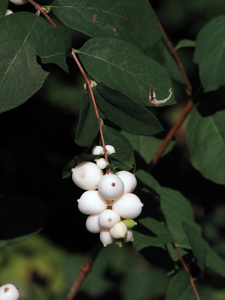Resource Library
Plant of the Week: Snowberry
The University of Arkansas System Division of Agriculture does not promote, support or recommend plants featured in "Plant of the Week." Please consult your local Extension office for plants suitable for your region.
Plant of the Week
Snowberry
Latin: Symphoricarpos albus

Deciduous shrubs often are scorned in the southland where evergreens form the backbone of the garden. But every garden benefits from change and the seasonal coming and going of leaves creates its own rhythm which helps make the evergreens even more pronounced. There may be even room for a scraggly shrub such as snowberry (Symphoricarpos albus) which produces showy white berries as the leaves depart for the winter.
Snowberry is a clump- and sometimes thicket-forming deciduous shrub of the honeysuckle family that grows about 6 feet tall and wide. It is native across much of the central part of Canada and adjacent northern states in the U.S. It is one of 15 species of Symphoricarpos that are described, with all but one found in North America. Coralberry (S. orbiculatus) is native across all of Arkansas and gives a good idea of the general form and appearance of snowberry.
Small, inconspicuous pinkish flowers to .25 inch long are produced in early summer in terminal spikes at the ends of newly formed growth. The real claim to fame for snowberry is its puffy, white, up to half-inch diameter berries that cluster together on the slender drooping stems. The berries turn color in late summer and, under perfect conditions can persist into the winter. Unfortunately, especially in warm climates, a blackish discoloration often overtakes the berries and reduces the length of the effective display to a few weeks instead of months as is often claimed.
The Symphoricarpos have never really caught on as landscape shrubs in the United States though they are occasionally seen in gardens in Europe. They have a fatal flaw – they look too much like so much uninspiring and uninteresting brush. Though offered occasionally in the nursery trade, it is still uncommon to encounter them in this country. For all the talk about the merits of natives, overcoming the gardener’s aversion for ordinariness is one of the biggest challenges.
Snowberry has a short effective display period in the fall so it should be used in locations where the berries play off of other plants such as asters or chrysanthemums that put on their peak display during that season. They can be grown as background shrubs or mixed into the perennial border where they are cut back every few years to keep them of a size with most perennials. While they flower on new growth, annual shearing keeps the plants in a perpetual re-growing phase of development where they never really produce a heavy fruit display.
They are hardy from zones 3 through 7 and are tolerant of most soil conditions and considerable drought. It will grow in full sun or moderate shade but like most fruiting plants, berry set is heaviest in brighter locations.
By: Gerald Klingaman, retired
Retired Extension Horticulturist - Ornamentals
Extension News - November 2, 2012
The University of Arkansas System Division of Agriculture does not maintain lists of retail outlets where these plants can be purchased. Please check your local nursery or other retail outlets to ask about the availability of these plants for your growing area.